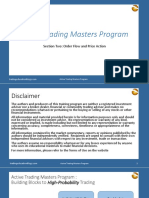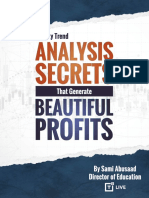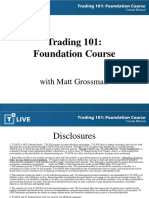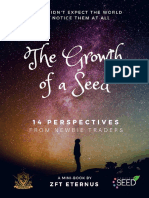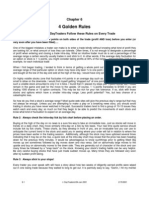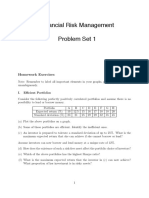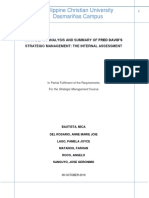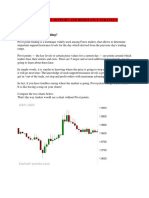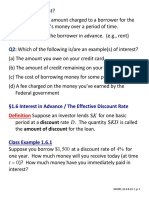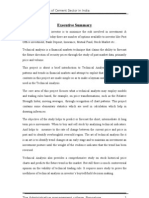Mastery Program Module One
Uploaded by
JinMastery Program Module One
Uploaded by
JinActive Trading Masters Program
How to Succeed as a Short-Term Trader
tradingeducationblogs.com Active Trading Masters Program 1
Disclaimer
The authors and producers of this training program are neither a registered investment
advisor nor a broker-dealer, financial or commodity trading advisor and makes no
recommendations whatsoever pertaining to the buying or selling of any stocks or other
financial instruments.
All information and material provided herein is for information purposes only and should
not be considered as investment advice. No representation or warranty of any kind,
expressed or implied, is made including but not limited to any representation or warranty
concerning accuracy, completeness, correctness, timeliness or appropriateness of the
information.
All information contained in the market commentary, reports or opinions published by the
authors should be independently verified. Recipients are urged to consult with their own
independent financial advisors with respect to any investment, trade or transaction.
The authors assume no responsibility whatsoever for any losses experienced by anyone
who uses its educational materials to make financial decisions.
For more information, please refer to the Terms of Use on the website
tradingeducationblogs.com Active Trading Masters Program 2
Highly Recommended…
• There are going to be A LOT of
things I am going to say to write
down, be prepared for it.
• I would also suggest you jot down
the section (1-5) and the page
number so you can go back and
review the concept.
• Best to watch once, then go back
and review for a maximum learning
experience.
• Use the big rocks, little rocks, sand
concept to retain the information
tradingeducationblogs.com Active Trading Masters Program 3
Active Trading Masters Program:
Program Outline
Part Three:
Part Two:
Trade Management
Edge: Trend Analysis
Entries, Exits &
Institutional Order Flow
Adjustments
Part One:
Core Knowledge
Goals and Experience
Part Four: Part Five:
Strategy Mindset
Trading Plan & Game Plan The Winning Edge
tradingeducationblogs.com Active Trading Masters Program 4
What You Are Going To Learn
Topics Objectives Obstacles
What Why How
Core Knowledge:
To Accomplish Main Challenge
Need to Know
Skill Development:
To Eliminate How to
How to Apply C.K.
tradingeducationblogs.com Active Trading Masters Program 5
Active Trading Masters Program :
Gaining the Experience You Need to Succeed
Long-Term Goals Short-Term Objectives
& Main Challenge & Obstacles
Part One:
Core Knowledge
“Street Smarts”
Defining Probabilities, Candlestick Charts:
Risk and Leverage Price Action DNA
tradingeducationblogs.com Active Trading Masters Program 6
Active Trading Masters Program :
Building Blocks to High-Probability Trading
Institutional Order Flow Trend Analysis
& Technical Analysis & Multiple Time-Frames
Part Two:
Edge: Trend Analysis
Chart Patterns &
Market Analysis
Potential Change of Trend
tradingeducationblogs.com Active Trading Masters Program 7
Active Trading Masters Program :
How to Make Money: Entries, Exits & Trade Adjustments
Entry Tactics & Profit Targets
Patterns & Trailing Stops
Part Three:
Trade Management
The Stop-Loss Oscillators &
& Planned Re-entries Order Types
tradingeducationblogs.com Active Trading Masters Program 8
Active Trading Masters Program:
How to Trade with Conviction
The Money Management
Trading Plan & Risk Management
Part Four:
Strategy
Assessing and Applying
Searching for Trade Ideas
Probability
& the Game Plan
Risk & Reward
tradingeducationblogs.com Active Trading Masters Program 9
Active Trading Masters Program:
How to Think and Trade Like a Professional
Mentor Advice Discipline &
Stories of Success & Failure Commitment
Part Five:
Mindset
How to Improve Why Winners Focus
Feedback & Outcomes On the Process
tradingeducationblogs.com Active Trading Masters Program 10
About
• Worked very hard collaborating with the team bringing you this
program today, multiple experienced traders have contributed…
• My Background:
• Entrepreneur for 25 years
• Trading over 20 years
• Full-Time prop trader for 14 years
• Series 24 for over ten years (manage licensed traders)
• 3 successful prop trading firms
• Two well-respected trading education firms
• Traveled the country for 8 years teaching stock trading seminars
• Mentored or managed thousands of traders in person and online
tradingeducationblogs.com Active Trading Masters Program 11
Words of Wisdom
• As we progress through this course your focus must be on
the steps and mindset that go into producing high probability
trades:
1. The process of finding a good trade scenario
2. The mindset for managing each trade.
3. The understanding of probabilities (over time).
4. The proper mindset for managing yourself.
tradingeducationblogs.com Active Trading Masters Program 12
“Only risk money on great ideas,
never justify a mediocre idea”
Words of Wisdom 2
Mark my words, this advice will save you tens of thousands of dollars.
There is a difference between a losing trading and a bad trade.
Learn to recognize, reduce and then eliminate bad trades.
tradingeducationblogs.com Active Trading Masters Program 13
Great Idea
vs. a Mediocre Idea
In this case :
“I see the risk”
Is not a great trade
The better idea is to be a buyer of a strong stock with
obvious institutional order flow than to enter a new
trade simply because you can identify the risk
tradingeducationblogs.com Active Trading Masters Program 14
Worth Repeating!
“Losing trades are a guarantee, strive to make them
great ideas that simply did not follow-through”
Words of Wisdom
Mark my words, this advice will save you tens of thousands of dollars.
There is a difference between a losing trading and a bad trade.
Learn to recognize, reduce and then eliminate bad trades.
tradingeducationblogs.com Active Trading Masters Program 15
“During the learning phase, much of your
focus should be on understanding the
difference between a great trade scenario
and everything else.”
News &
Market Industry Stock MTFA
Numbers
• Tip: Before you allocate money to a new idea, ask yourself it is a great idea.
• This training will help you learn how to do this, the skill of managing trades is a separate skill
from finding one..
• No matter how long you have been a trader, you are still a beginner until you are earning money
with consistency.
tradingeducationblogs.com Active Trading Masters Program 16
So the Big
? How do you transform from a beginner trader to a
successful trader?
Develop an EDGE So You Can Test and Get Feedback with Begin Making a BIG List of
Believe in Your Strategy Real Trades & Small Shares What NOT to DO
You Can’t Trade
Everything; Find the Motivation to
Narrow Your Your
Focus Have a Probability Mindset
Resources are Trade Disciplined
Limited
tradingeducationblogs.com Active Trading Masters Program 17
Recommended books
tradingeducationblogs.com Active Trading Masters Program 18
The Cost of Learning to
be an Accomplished Active Trader
• Learning to trade is simple. Learning how to make money takes time.
• Before you can learn how to make money, you need to learn how to
not lose it. You need to pay for experience.
• This “payment” can be training or it could be real money trading and
feedback; the best combines the two.
• To be clear, learning to not lose is your first goal. This means
protecting your capital while taking educated risk.
• Your second goal is to learn how to hold winning trades longer.
• Without number one, you will not have money to learn number two.
tradingeducationblogs.com Active Trading Masters Program 19
The Active Traders Journey
1. Desire to earn money from the stock market.
2. Study the many strategies that have an edge. Study the general market.
3. Review your resources.
4. Decide on realistic goals.
5. Choose a strategy that matches your personality, resources and goals.
6. Learn how to place all of the order types you will need as a trader.
7. Open an account.
8. Place small trades to gain experience and journal feedback from the
results.
9. Make changes to develop a strategy that works for you.
10. Trade your strategy flawlessly.
tradingeducationblogs.com Active Trading Masters Program 20
Trading your Strategy Flawlessly:
What that looks like for an accomplished trader.
• Develop a strategy that has an edge you believe in.
• Have strict criteria for identifying trade set ups.
• Plan a specific dollar amount you are comfortable placing at risk for each
new trade.
• Identify your risk reward points.
• Know your exact entry and exit patterns.
• Write down, before the trade, how you will know if the scenario has
changed.
• Plan how you will accumulate your position.
• Follow your plan with discipline.
• React to each profit or loss with indifference and a probability mindset.
tradingeducationblogs.com Active Trading Masters Program 21
Goal Setting Based on Your Resources of:
Capital-Market Experience/Edge-Trading Skill Level
Write down how much you
want to earn
over the next 12 months
Now DOUBLE that #
Write down what you believe
you need from this course to
make the higher # possible
tradingeducationblogs.com Active Trading Masters Program 22
Part One:
Core Knowledge & Street Smarts
Setting the Stage for Successful Active Trading
tradingeducationblogs.com Active Trading Masters Program 23
Active Trading to Win:
Setting the Stage for Successful Active Trading
Long-Term Goals Short-Term Objectives
& Main Challenge & Obstacles
Part One:
Street Smarts
Probabilities, Risk and Candlestick Charts:
Leverage Price Action DNA
tradingeducationblogs.com Active Trading Masters Program 24
Streets Smarts Defined
• Experience
• Understanding of what to do and what not do
• Honesty about your resources
• Realistic goals
• Define Your Goals And Objectives
• Thinking Strategically
• Self Analysis
• Potential Markets To Trade
• Choosing A Trading Concept
tradingeducationblogs.com Active Trading Masters Program 25
Your Requirements for Success Book Bonus:
Mindset
By Carol Dweck
• Your capital is truly risk capital.
• You operate your trading account as a serious business.
• You strive for profits but manage risk first.
• Never get emotional about a trade.
• Never trade with an opinion that will impede judgment.
• Take the time to develop and commit to a clear strategy.
• Only trade when you have an edge.
• View trade results as feedback to improve.
tradingeducationblogs.com Active Trading Masters Program 26
Long-Term Goals: Strategic Thinking
• How to identify low risk ideas with acceptable profit potential
• A solid understanding of how to mange money (risk) as a business
• The opportunity to ask those who are further down the trader path for advice,
networking and mentoring.
• Define the outcome you imagine trading to be:
• Why do you want to trade?
• What do you enjoy when trading?
• What type of trader do you want to be? (very often this is different from what
you think after you do some planning)
• What skills are needed to succeed at this?
• How do you plan to improve the skills you already have?
• How do you plan to develop the skills you don’t have?
tradingeducationblogs.com Active Trading Masters Program 27
Main Challenges to Overcome
in Pursuit of Your Long-Term Goals
• The Desire To Be Further Along Than Your Resources:
Time: to learn, to give a system enough trades to assess the edge, to
develop a plan, to game plan
Risk Capital/leverage: too little, too much
Education: none or little, not continuing/ no advice from a coach or
mentor
Wrong education: not relevant, wrong style for you personally
Experience: You have no track record and history of actual trades
with a detailed journal (why is this a challenge?)
tradingeducationblogs.com Active Trading Masters Program 28
Time to:
• to learn
• to give a system The less time you have to
accomplish these
enough trades to components, the greater
assess the edge your need to
narrow your focus
• to develop a plan
• to game plan
Ask A LOT of questions and keep a detailed journal…
tradingeducationblogs.com Active Trading Masters Program 29
Defining your strategic choices
• What is your edge? What is the concept you are trading that you feel will
earn money? (technical, news, value, momentum, scalping, position)
• How much money do you have personally? How much can you afford to
lose or invest in your trading business? This includes capital to trade and
living expenses. This will ALWAYS be longer than you expect
• How much risk can you afford to take on each trade, day, week and
month?
• How much money do you need to earn each year? Do you need to earn
all of that from trading?
• What if you don’t make enough from trading to live off of, what are our
contingency plans and when will you take action on this?
tradingeducationblogs.com Active Trading Masters Program 30
Defining your trading goals and objectives
• Can you make more money than you need to live off of so that your
trading capital can grow?
• Based on the above are you being realistic or do you anticipate trading
like a seasoned professional from the start?
• How will you educate yourself after you begin trading your system?
• How much do you expect to make as a percentage of your trading
capital? (prop traders as well)
• What risk level are you willing to accept to achieve that?
• What is the largest drawdown you are willing to accept on a daily, weekly
and monthly basis?
• How will you know your plan is working or not working? Who can you ask
for advise or mentoring?
tradingeducationblogs.com Active Trading Masters Program 31
Skills Needed to Succeed Advanced Topic:
Will you only trade Game
1. How to pick an execution platform Plan ideas from pre market
2. How to pick a charting package scans or will you look for new
3. Understand all types of orders ideas intra day?
4. How to decide on a trading concept or trading business to open
5. How to determine necessary education or continuing education
6. How to write a trading plan
7. How to convert your trading plan into a game plan
8. How to write a trading journal, how to USE your trading journal
9. How to scan or evaluate ideas (both before the market and during market hours)
10. How to determine proper risk for your resources
11. How to manage leverage
12. How to manage scaling in and out of a trade
13. How to read the general market
14. How to understand liquidity and volatility “ATR” and momentum
tradingeducationblogs.com Active Trading Masters Program 32
Why is this an “Advanced Topic?”
• Our job is to “hop on the back” of
Institutional Order Flow
• When big money makes a
Advanced Topic: commitment, it is for an absolute
Will you only trade Game Plan ideas minimum of the next quarter- or
from pre market scans or will you look until the company reports again.
for new ideas intra day?
• When a stock has an imbalance
from IOF we get an obvious trend
to trade and put into our game plan
• What do you plan to do if TODAY
your stock trades against that
trend?
tradingeducationblogs.com Active Trading Masters Program 33
Trading Plan Decisions…
• Solid IOF
• Buying opportunity for several
months
CVX Weekly
• What do you plan to do on the
days when there is more selling
than buying?
Buy no matter what?
Look for another stock to trade?
Short-sell intraday weakness in a
strong stock?
Call your mama and ask for
help?
Wait for the right time to be a
buyer again?
tradingeducationblogs.com Active Trading Masters Program 34
Trading Plan Decisions:
strong stock, weak intraday
#1: You are a buyer regardless #2: Look for another
of the intraday price action! stock to trade?
Yes and no tough to be consistent
#3: Short-sell the intraday #4 Wait for the right time Future
weakness in your strong stock? to be a buyer again? Lesson!
trading against IOF highest probability
tradingeducationblogs.com Active Trading Masters Program 35
Short-Term Objectives
• Get relevant training and education
• Planning; Trading Plan and Game Plan
• Learn to place live trades with predefined risk (and you accept the
risk fully)
• Review plan and results with a successful coach or mentor (think
intern/doctors)
• Revise plans and trade again
• If consistent, learn how to trade bigger
tradingeducationblogs.com Active Trading Masters Program 36
Obstacles to Achieving
Short –Term Objectives
• Get relevant training and education: “figure it out” mentality
• Planning; Trading Plan and Game Plan: Requires hard work
• Place live trades with predefined risk: Profit focused/risk after-
thought
• Review plan and results with a successful coach or mentor (think
intern/doctors): Hard to find, won’t listen if you do
• Revise plans and trade again: Outcome focused vs. process
• If consistent, learn how to trade bigger: Want to versus should
tradingeducationblogs.com Active Trading Masters Program 37
Core Definitions:
Probabilities, Risk and Leverage
• Probabilities: the odds of an occurrence happening over time or a
large sample. The lines between probable versus definite are often
blurred and confused.
• Risk: The potential of monetary loss or career. Whether the risk is
accepted or not by the trader will determine chances of success.
• Leverage: The use of additional capital; generally a multiple of cash
equity but can be significantly larger for proprietary traders with
experience and proven track record.
tradingeducationblogs.com Active Trading Masters Program 38
Understanding Probabilities
1. The odds of an occurrence
happening
2. over time or a large sample.
• Trading is not gambling but you must
understand how they are similar to
succeed.
• Every trade is your assessment of the
risk you would take for the potential
reward. Every decision.
• Shorting a double top versus buying a
pull back in an obvious trend.
tradingeducationblogs.com Active Trading Masters Program 39
Applying Probabilities and the Right Mindset
• There are certain scenarios that
Stock specific
simply have a higher probability, order flow
the potential for reward is greater.
• THIS MEANS you should risk more
to earn more. Order flow is obvious in
specific sectors or industries
• If you do not earn money on this
trade it was still the correct play…
Basic set up for determining trade Obvious order flow is broad based
across: general market, sectors and stocks
expectations
tradingeducationblogs.com Active Trading Masters Program 40
Trading plan incubation: making it/working it
Trading the relationship between expectation and
risk/reward more consciously
Managing multiple conditions and positions
hedging
Being in the right stocks, identifying the highest
Skill Development probabilities for follow through ( both before and during
Checklist trading hours)
Holding winners, cutting losers
Identifying which setups work best for a particular
environment
Game planning with conviction
Tape reading skills and APPLYING it
tradingeducationblogs.com Active Trading Masters Program 41
Learn how to recognize and take advantage of when
more is available
Recognizing if there is nothing to do and being OK with
that
Keeping focus on why I thought a trade as a good idea
and paying attention to if its still valid
Skill Development Only trade my own ideas, eliminate impulsive trades
Checklist Removing stress from my trading
Cultivate a “core list”
Journal better, record my thoughts during a trade and
immediately after
Purposefully be more aggressive in great ideas
Pattern recognition, and recognize noise versus a
change
tradingeducationblogs.com Active Trading Masters Program 42
Not recognizing moving averages do not have any significance in
flat markets
Trading someone else's ideas and impulsive ideas
Being greedy when the tape is slow
Exiting trades that are in the “gray area” without a good reason
Not being completely prepared (which includes getting enough
rest)
Trading against clear order flow trying to get an early entry
(top/bottom fishing)
Stumbling Blocks Anticipating entries on pullbacks or breakouts instead of waiting
for price confirmation
Trading your P&L instead of the scenario
Trading a breakout inside a trading range
Giving bad trades more room than planned
ALLOWING yourself to have a really bad day
Being passive on great days (not making enough on those days to
pay for the small losses)
tradingeducationblogs.com Active Trading Masters Program 43
Recognizing poor decisions after the market
Finding the best order flow for your strategy
Being in the right trade but not making money
Inability to follow my plan
Inconsistent results, lack of progress (symptoms of no strategy)
Giving back profits
Missing planned opportunities
Waiting for too much confirmation
Your Biggest Not being in sync with the market
Challenges and Exit a trade for a loss and it becomes profitable
Frustrations Hesitating on obvious good ideas
Wanting big profits all the time
Developing a daily routine and structure
Short term noise (algos)
Frustrated when a stock does not move after you enter
Always feel the need to do something
Learning when to take momentum profits versus when to hold
tradingeducationblogs.com Active Trading Masters Program 44
Candlesticks
Interpreting the Foundation of Price Charts
A short-term picture of supply and demand.
tradingeducationblogs.com Active Trading Masters Program 45
Goals
• To introduce candlestick charts and to understand the
price action that forms the candlestick.
• To introduce basic candlestick patterns and understand
how to apply them.
tradingeducationblogs.com Active Trading Masters Program 46
candlestick charts: Actual trades become pictures
• When you buy or sell a stock the transaction is recorded on
“the tape.” (this is also known as a “print”)
• The trades are recorded and structured into specific time
frame formats; 1 minute, 5 minute, 15 minute, 60 minute
hourly daily and weekly are the most common.
• The trades that occur between the open, high, low and close
for a particular time frame will form a pattern.
• Candlestick charts display a stocks price action using color to
show us what happened in that time.
• Candlesticks place emphasis on the most current battle
between supply and demand.
tradingeducationblogs.com Active Trading Masters Program 47
Quotes,
become prints,
displayed on the candlestick chart
tradingeducationblogs.com Active Trading Masters Program 48
the forming of the candlestick
• Each candlestick has a body and a wick.
• The color of the body shows the relationship between the opening and
the closing price, the color is a very important characteristic.
1.A green body is formed when the closing price is above the opening
price. These candles are bullish, showing us the buyers won the battle.
2.A red body is formed when the closing price is below the opening price.
These candles are bearish, the sellers won the battle.
3.The wick is the part of the candle above and below the body. The wick
shows us the high and low of a candle.
tradingeducationblogs.com Active Trading Masters Program 49
bar chart vs. candlestick
tradingeducationblogs.com Active Trading Masters Program 50
Price action history in a picture: “print over time”
bullish
bearish
tradingeducationblogs.com Active Trading Masters Program 51
How To Properly Use
Candlestick Charts To Make
Sound Trading Decisions
Charting Tactics:
The first two candles
you need you learn and how to use them
tradingeducationblogs.com Active Trading Masters Program 52
Energy candlesticks
• Bullish energy candlesticks have large
bodies, open near their low and close near
their high.
• Bearish energy candlesticks have large
bodies, open near their high and close
near their low.
• Typically this price action represents a high
energy move.
• Where it occurs in price action will tell you
if it is stored up energy (beginning of a
move) or exhaustive energy (a capitulation
move)
tradingeducationblogs.com Active Trading Masters Program 53 53
“melted candle”: reversal of momentum
• Melted candles represent a potential reversal of momentum
• Melted candles are recognized by a small body, the color of the body is
not important.
• The body near the high or low can mean buyers or sellers were in charge
despite the body size.
• Look for melted candles to slow price action after at least two
consecutive higher highs or lower lows.
• The closer you get to six consecutive higher highs or lower lows the more
likely a reversal will occur after a melted candle.
• Melted candles represent indecision…
tradingeducationblogs.com Active Trading Masters Program 54
The Inside Candle
• The current candle is completely
inside the previous candle
• Represents indecision or pause in
price action.
• The correct play is to wait for a
breakout from the inside candle
• Typically an entry signal.
• ** outside candlesticks are neutral
tradingeducationblogs.com Active Trading Masters Program 55
Energy, melted candles, inside candles
tradingeducationblogs.com Active Trading Masters Program 56
Candlesticks in
Multiple Time Frames
• It’s important to learn from the start,
that candlestick patterns can be
viewed in various time frame frames.
• Different trading styles will affect
which time frame you will monitor.
• The green candle to the left could be
a 5 minute window
• The red candle could be a one month
candle.
• Each represents the open, high, low
and close for that period.
tradingeducationblogs.com Active Trading Masters Program 57
Candlesticks in
Multiple Time
Frames
tradingeducationblogs.com Active Trading Masters Program 58
Candles telling a deeper story:
Well-bid, well-offered and the close
1) lower high
1) Higher high 2) lower low
2) Higher low 3) Close below
3) Close above previous close
previous close 4) Close below
4) Close above previous high
previous high 5) Sellers
5) Buyers currently in
currently in control
control 6) Well-Offered
6) Well-Bid
tradingeducationblogs.com Active Trading Masters Program 59
Well bid/well offered
• When two candlesticks form a higher high and a higher low and the
last price is above the previous close it is considered well bid.
This is caused by institutional demand supporting higher prices
• When two candlesticks form a lower high and a lower low and the
last price is below the previous close it is considered well offered.
This is caused by institutional supply being offered to the market
* If well-bid or well-offered and the last price is outside of the
previous trading range this is a “+” scenario (consider more leverage)
• ** for those of you who are “old school” traders you will remember well bid
meant that Goldman Sachs was advertising to buy a stock in level 2 quotes!
tradingeducationblogs.com Active Trading Masters Program 60
well bid/well offered, energy, inside & melted candles
• As long as a stock remains well
bid or well offered you should
remain in the position
• When a melted candle or inside
candle forms, consider scaling
out or at least placing a trailing
stop loss
• The concept of well bid, well
offered and melted candles
applies to all time frame charts
(this picture displays a 5 minute
chart)
• The higher the time frame the
more significant the pattern
tradingeducationblogs.com Active Trading Masters Program 61
Daily chart price action trade scenario
• Multiple well bid or offered candlesticks on a daily chart display continued
institutional buying or selling
• A typical momentum move on your entry time frame is two-six well
offered or well bid candlesticks. (profit taking considerations)
• Buying or “a mark up” is 2-6 higher highs and higher lows on a daily chart
• Selling “mark down” is 2-6 lower lows and lower highs on a daily chart
**Our strategy outlines we execute trades in sync with IOF, the technical
catalyst of energy and well bid or well offered, and time the entries and
exits using melted candles, inside candles, swing points, hammers and
shooting stars. (more on a few of these later)
*** there are literally hundreds of different names for candlestick
patterns, keep it simple: energy or indecision. Your goal is to be a trader,
not a candlestick history professor.
tradingeducationblogs.com Active Trading Masters Program 62
Key lesson and a strategy to apply
• Individual candlesticks show us energy or indecision
• The patterns of well bid or well offered create very low risk trades
because institutions are bidding up or selling down a stock at this
moment.
• When you combine Institutional Order Flow with:
1. Daily chart candlestick analysis
2. with well bid or well offered
3. With energy candlestick recognition
4. with melted candles & inside candles
• you have an edge, trade management and profit taking scenario
tradingeducationblogs.com Active Trading Masters Program 63
Must Know Trading Terms
• Long: If you are long a stock it means you have bought shares.
• Short Sale: If you sold a stock “short,” you have sold stock that is borrowed
from your brokers inventory; your analysis is anticipating the stock price to
decline. Your goal is to Sell short high and buy back low.
• Cover: When you execute a short sale, you must buy the stock back to exit
the trade. Buying back a short sale is called “covering.” (as opposed to
buying or entering a new “long position.”)
• Sell: You are exiting a trade from which you have bought shares.
• Bullish: You believe the stock is going higher. (a bull strikes upward)
• Bearish: You believe a stock is going lower. (bears strike down with their
paws)
tradingeducationblogs.com Active Trading Masters Program 64
Short Selling Mechanics
Sell @ $11 If you go “long,” or buy Sell Short@ $11
@$10 and sell at $11,
you earned $1 profit.
If you go “short,” or
execute a short sale
and cover @$10, you
also earned $1 profit.
In both trades, the
difference between
Buy @ $10
where you entered and
exit, is the profit or Cover @ $10
loss.
tradingeducationblogs.com Active Trading Masters Program 65
How do you short-sell stock you don’t own?
• Your brokers has many clients who own XYZ stock, the brokerage clients
are the buyers.
• You, as a short seller, borrow the shares of stock from your broker.
• When you cover the trade (buy back the shares you borrowed) the stock
shares go back into your brokers inventory.
• In many cases a broker will charge a fee to borrow the shares.
• The obvious risk of short selling is unlimited losses because technically a
stock can rise infinitely.
• A buyer can only lose to $0 zero. So technically he has defined risk.
• **All trades (long or short selling) require proper risk management.
tradingeducationblogs.com Active Trading Masters Program 66
Core Knowledge Recap:
• Before you set goals you need to be honest about your resources: time,
experience, capital, skills…
• To position yourself for success, be honest about your resources so you have the
best chance to succeed.
• Determine the resources you need and how to get them.
• Core knowledge is what to do. Core skills are how to apply the knowledge
profitably.
• Knowledge is easy, skills require a commitment.
• Develop your edge with real money trades and be diligent keeping a journal to
record results and feedback to improve.
• Candlesticks form the DNA of price charts: energy, indecision, well-bid or well-
offered is your foundation.
• Institutional Order Flow is our North Star..
tradingeducationblogs.com Active Trading Masters Program 67
You might also like
- Six Costliest Trading Mistakes: (And How To Immediately Fix Them)0% (1)Six Costliest Trading Mistakes: (And How To Immediately Fix Them)13 pages
- T3live Unsexy Trend Analysis Secrets SAMI ABUSAAD100% (1)T3live Unsexy Trend Analysis Secrets SAMI ABUSAAD18 pages
- Scott Redler Super Simple Gap Trading Ebook100% (4)Scott Redler Super Simple Gap Trading Ebook18 pages
- A Trader CheckList - ActiveTraderIQ ArticleNo ratings yetA Trader CheckList - ActiveTraderIQ Article3 pages
- ABS Risk Management Simulator v1.1: Case 1: Lose - Stop Loss Hit Case 2: Lose - Loss by SlippageNo ratings yetABS Risk Management Simulator v1.1: Case 1: Lose - Stop Loss Hit Case 2: Lose - Loss by Slippage5 pages
- FXCM Traits of Successful Traders Guide PDF100% (1)FXCM Traits of Successful Traders Guide PDF44 pages
- The Search For The Holly' Grail: Brian Shannon @alphatrendsNo ratings yetThe Search For The Holly' Grail: Brian Shannon @alphatrends37 pages
- Toshimoku's Trading Tips & Tricks - #SatoshiMoku - CarpeNoctom - Medium PDFNo ratings yetToshimoku's Trading Tips & Tricks - #SatoshiMoku - CarpeNoctom - Medium PDF54 pages
- Follow The Money - Trade Where The Action IsNo ratings yetFollow The Money - Trade Where The Action Is4 pages
- 2ND UPDATE Parabolic Theory-Based Stock Trading and Some ReflectionsNo ratings yet2ND UPDATE Parabolic Theory-Based Stock Trading and Some Reflections14 pages
- SW-Andrew's Secrets Trading The First 5 Minutes100% (3)SW-Andrew's Secrets Trading The First 5 Minutes50 pages
- Self Sabotage Reexamined: by Van K. Tharp, PH.DNo ratings yetSelf Sabotage Reexamined: by Van K. Tharp, PH.D8 pages
- Sam Seiden - Active Trader Magazine Sept 2006 PDF100% (2)Sam Seiden - Active Trader Magazine Sept 2006 PDF2 pages
- Expert Trader 93 Trading Lessons of Richard Wyckoff by Frank MarshallNo ratings yetExpert Trader 93 Trading Lessons of Richard Wyckoff by Frank Marshall27 pages
- 21 Questions You Should Answer in Your Trading PlanNo ratings yet21 Questions You Should Answer in Your Trading Plan5 pages
- So You Want To Be A Trader How To Trade The Stock Market For The First Time From The Archives of New Trader University by Steve Burns, Holly Burns100% (2)So You Want To Be A Trader How To Trade The Stock Market For The First Time From The Archives of New Trader University by Steve Burns, Holly Burns52 pages
- 20 Rules Followed by Professional TradersNo ratings yet20 Rules Followed by Professional Traders8 pages
- Consumer Assistance Program Application: Receive Up To $1,500 To Retire Your VehicleNo ratings yetConsumer Assistance Program Application: Receive Up To $1,500 To Retire Your Vehicle0 pages
- ReSA B46 AFAR Final PB Exam Questions Answers SolutionsNo ratings yetReSA B46 AFAR Final PB Exam Questions Answers Solutions24 pages
- Philippine Christian University Dasmariñas CampusNo ratings yetPhilippine Christian University Dasmariñas Campus14 pages
- Deficit Balance of Payments, Causes and ControlNo ratings yetDeficit Balance of Payments, Causes and Control8 pages



